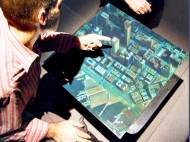Zebra Imaging digital prints provide eyewear free 3D images
 We already wrote many articles regarding 3D image reproduction such as 3D displays, physical 3D pixels, and various ways to simulate holography as well as the real photography stored in 3D, and in this article we’re going to write about holographic digital prints from Zebra Imaging, a company founded in 1996 by graduates of the Massachusetts Institute of Technology’s (MIT) Media Laboratory.
We already wrote many articles regarding 3D image reproduction such as 3D displays, physical 3D pixels, and various ways to simulate holography as well as the real photography stored in 3D, and in this article we’re going to write about holographic digital prints from Zebra Imaging, a company founded in 1996 by graduates of the Massachusetts Institute of Technology’s (MIT) Media Laboratory.
Holographic digital prints enable analysis from almost every angle by delivering a richer, more compelling visual experience. The technology enables with a 360- degree viewing range without any required eyewear. Unlike physical models that could be modeled or printed in 3D via rapid prototyping, you can easily produce multiple “leave behinds” for clients, investors and other stakeholders. Unfortunately, the prints themselves are currently not as affordable as some of the alternative solution and are more suitable for eye-catching effect.
So how it all works? The data is rendered into tens of thousands of component hogel images that are recorded by laser light into a single portable, film-based hologram that can be viewed with a simple halogen or LED light source. When the hologram is illuminated with such a light source, the light is reflected and controlled by hogels and combines and emerges from the hologram surface in the same way it would if a solid physical model were actually there. The process is designed to accept a wide array of source data digital file formats — including CAD models, laser scans (LIDAR information) and satellite imagery.
Zebra Imaging holographic prints come in full-color or monochrome formats. Since it is capable to store up to 4 layers or different images, you can store complex information which cam be displayed with brilliant detail, transparency and color. Layering enables you to store multiple images or additional information that could help with additional information about the exhibited image.
Digital prints are typically laminated on a flat, lightweight surface, such as aluminum or plastic, which can in turn be mounted almost anywhere. They come in three formats – horizontal for displaying flat on a table, incline for display on an angled stand, or vertical for wall mounted prints. The output angle of a horizontal-mode Zebra Imaging hologram is about 100°, so you can comfortably view these images within a cone of about 50° off the center axis. Although they can be viewed in direct sunlight, holograms are best displayed indoors or at night with a single light source shining directly upon them.
Since holographic prints are basically a sheet of material, they are easy to transport or send. The prints come with protective coatings for durability, and they can be marked on and rolled up as well. 3D images are “version proof” and store flat, so you can refer to them years later — without the need for a computer or specific software. The prints can be viewed even underwater as long as there is proper underwater illumination.









author
ZScape Color pricing begins at $1,500 for a 30.5 x 45.7 cm (12 x 18 inches) print and goes up to $ 3,500 for the largest 61 x 91.4 cm (2 x 3 feet) print size. ZScape Mono pricing begins at around $700 for the smaller size print and goes up to around $2,000 for the largest print size. Custom options and graphics work are paid additionally.
Price varies by size and complexity so it’s best to check their site for contact and additional information. Some of the holographic products can be tiled and mounted together to form a unique, large-format holographic print, thus enabling even larger format of prints.